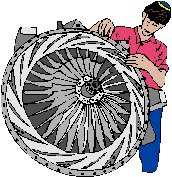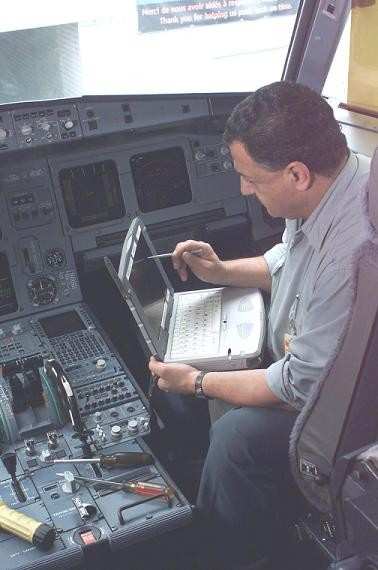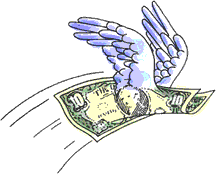Contract Airline Maintenance Reaches 60-Percent
 Where is the center of US commercial
passenger aircraft maintenance? Here's a hint: It's moving further
and further to the south. Pretty soon, it may not be in the US
anymore.
Where is the center of US commercial
passenger aircraft maintenance? Here's a hint: It's moving further
and further to the south. Pretty soon, it may not be in the US
anymore.
In fact, you'll have to go quite a bit further south to find out
where companies like JetBlue and America West send their aircraft
for insection and overhaul -- as far south as El Salvador. The Wall
Street Journal reports more than half of all US flag aircraft in
the civil fleet are now maintained by outside companies and many of
them are altogether outside the US.
A sign of changing economic times, that's up from less than
35-percent sent to outside contractors just 15 years ago.
It's the heavy work that most often ends up being done outside
an airline's own hangars. In addition to JetBlue and America West,
other airlines like Southwest, Continental and bankrupt United send
their aircraft to outside contractors. Executives at some of those
airlines are quoted as saying the indeed have concerns about the
quality of work performed at these outsourcing shops.
"We don’t want transient labor on our aircraft," Jim
Sokel, Southwest’s vice president of maintenance and
engineering, told the WSJ.
"The industry is losing its skills," said John Goglia, a former
mechanic who recently stepped down after nine years as an NTSB
member. He, too, was quoted in the Journal.
Not everyone in the industry is down on the idea of outsourcing
major maintenance. United's VP of maintenance, Greg Hall, says the
quality of the work done by outside shops is pretty good. "We give
them a lot of oversight," he told the financial daily. "We give
them training on our maintenance program and our tooling. We do
frequent audits."

But in the final analysis, only supervisors in each of these
third party shops have to be licensed by the FAA. But the
Department of Transportation's Inspector General found in a recent
investigation that the FAA is negligent in overseeing these
contract shops. The Journal reports, while the FAA examined the
practices of airline maintenance shops some 400 times in 2002, it
only inspected seven contract shops during that same period of
time.
Last year, the NTSB cited faulty maintenance at a contract shop
as a contributing factor in the 2003 crash of a US Airways Beech
1900 that went down at Charlotte-Douglas International in North
Carolina, killing all 21 people on board.
Since the DOT IG report, the FAA has started keeping closer tabs
on contract maintenance shops. The FAA's chief of flight standards,
James Ballough, told the Journal that his department now inspects
4,500 repair stations here in the US and 650 in other countries.
While he said the FAA can't look over the shoulders of contract
A&Ps, "there certainly is no degradation of safety due to
outsourcing."
 Face it. There's a strong economic
incentive for airlines to send this work out of house and out of
country. Even after obtaining contract concessions from their
employees in hopes of staying in the air, legacy carriers are still
paying up to $70 an hour for employee-driven maintenance. Team SAI,
a consulting operation based in Colorado, says contract shops
charge $50 an hour or less. In Central and South America, that cost
goes way down -- as low as $20 an hour.
Face it. There's a strong economic
incentive for airlines to send this work out of house and out of
country. Even after obtaining contract concessions from their
employees in hopes of staying in the air, legacy carriers are still
paying up to $70 an hour for employee-driven maintenance. Team SAI,
a consulting operation based in Colorado, says contract shops
charge $50 an hour or less. In Central and South America, that cost
goes way down -- as low as $20 an hour.
As economic pressure continues to mount on the legacy carriers,
so will the pressure to outsource costly maintenance. And as it
does, so will the challenge for the FAA to keep up.
 Unfortunate... ANN/SportPlane Resource Guide Adds To Cautionary Advisories
Unfortunate... ANN/SportPlane Resource Guide Adds To Cautionary Advisories ANN FAQ: Turn On Post Notifications
ANN FAQ: Turn On Post Notifications ANN's Daily Aero-Term (04.29.24): Visual Approach Slope Indicator (VASI)
ANN's Daily Aero-Term (04.29.24): Visual Approach Slope Indicator (VASI) ANN's Daily Aero-Term (04.28.24): Airport Marking Aids
ANN's Daily Aero-Term (04.28.24): Airport Marking Aids ANN's Daily Aero-Linx (04.28.24)
ANN's Daily Aero-Linx (04.28.24)





